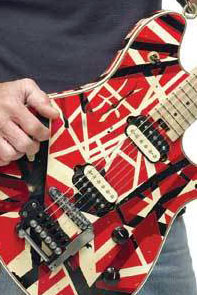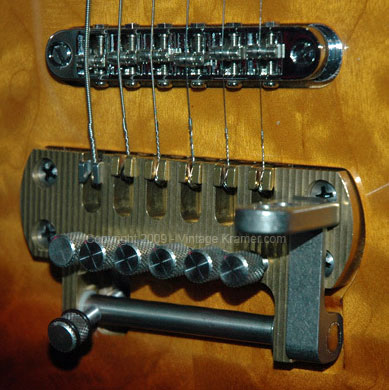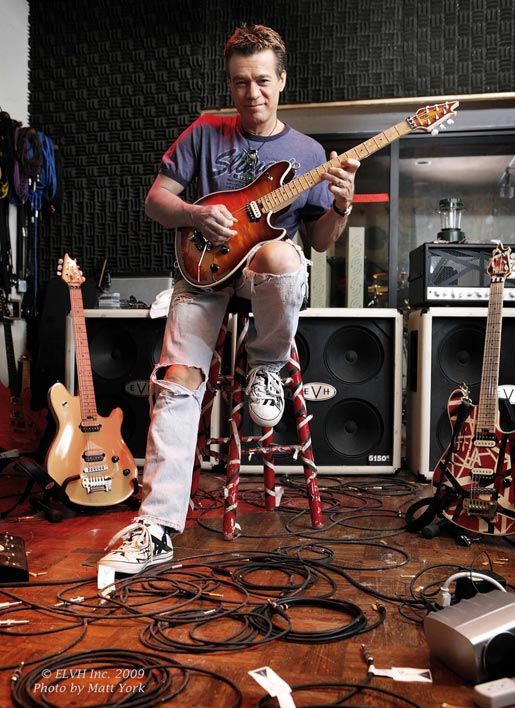What Exactly Is the D2H Tailpiece?
 With the release of the EVH sneakers, the only piece of EVH gear left to see the light of the day – presumably for now – is the Drop To Hell tailpiece, or D2H. Although a few pics of it have been posted on the Internet, no one’s really sure about the whys and whats of the D2H.
With the release of the EVH sneakers, the only piece of EVH gear left to see the light of the day – presumably for now – is the Drop To Hell tailpiece, or D2H. Although a few pics of it have been posted on the Internet, no one’s really sure about the whys and whats of the D2H.
So what to do? Read the patent application – whose apparent purpose is to repeat things ad nauseum while never really making clear what the heck the thing is. Anyhow, here are the highlights:
> “An apparatus for adjusting the tension of at least one string of a stringed musical instrument.”
> “The tailpiece includes a lever that can be used to adjust the tension of a guitar string (or, alternatively, multiple guitar strings).”
> “The tension adjustment mechanism may be associated with more than one string, or multiple tension adjustment mechanisms may be included in a single tailpiece assembly.”
> “While various embodiments described herein have generally been discussed in terms of dropping down pitch by decreasing string tension, alternatively such embodiments may be viewed, and utilized, as a tension increasing mechanism, wherein the normal playing pitch is the lower pitch, and the string tension adjustment mechanism is activated to occasionally increase string tension on demand.”
> The application specifically tries to differentiate this from a whammy: “Conventional techniques for adjusting the tension of musical instrument strings may suffer from various drawbacks. For example, with a tremolo bar, the shift in the tension or tone of a string depends upon the amount of physical displacement of the bar, and is therefore relatively imprecise. Also, the tremolo bar generally affects all of the strings simultaneously. In various other techniques, the amount of potential change in the tension of a string may be limited. Also, the mechanism for adjusting the tension of the string may be inconvenient or difficult to use, particularly during live performances or other renditions.”
Pending the official announcement of details from EVH, here’s how I read the application along with looking at the available photos:
1. Right now the D2H is for quickly dropping just the low E string to D or lower, while, thanks to the Floyd nut, keeping the whole guitar in tune.
2. I believe the application mentions the possibility of dropping “multiple guitar strings” (presumably in tune) as legal CYA in case that is possible or desirable, or in case someone decides to make a six-string version of a D2H. But I have to wonder if Gibson, which now owns Steinberger, might take issue with that.
Of course, I could be dead wrong.

Photo courtesy VintageKramer.com
Without seeing and hearing what the D2H does, I have to wonder how practical this would be: How many people would want to rout their tailpiece areas to accommodate the D2H and rout their necks for a Floyd nut?
None of this info and speculation explains the why, however. Is Ed all of a sudden going to play multiple songs with one, non-Floyd guitar? (I doubt it, but that could be cool.) If not, couldn’t he just change guitars like he used to for Unchained and the other detuned-low-E tunes?
Notable
> Speaking of playing a new type of guitar and possibly writing new types of material, I’ll leave you with this ditty from rollingstone.com: “I’ve got tons of music written, such a variety of stuff,” says Eddie, who thinks some of it may surprise fans. “The essence of me is obviously there, and those drums, they’re always recognizable. But people expect a certain thing from Van Halen, and this isn’t exactly bang-your-head-against-the-wall stuff.” [So I guess another “Loss of Control” ain’t happenin’?]

Category: Edward Van Halen
Comments (5)
Trackback URL | Comments RSS Feed
Sites That Link to this Post
- WoodyTone! - EVH’s Two and a Half Men Riff, Extended Version | September 28, 2009














Looks like all Ed is doing is reinventing the Les Paul again. If you look at the evolution of what he has done, he’s basically taken a Strat and turned it into a Paul. First it was just a pickup. Then, he goes and makes a new body that looks similar to a LP, puts two humbuckers in and a toggle switch and goes with that for a while.
Then, he goes over to Peavey and has them make an arch top of the EB model, add some binding to it and, it’s getting closer to a LP minus scale length and set neck and a stop tailpiece and tun-o-matic style bridge.
Next up, we have this new LP style bridge scheme. Modded after a badass tailpiece and bridge combo. Those levers were used by Hipshot years ago. I think I have one new in a box someplace. Angle the necks back, tilt headstock, LP style controls etc.
Other than changing the scale length from 25.5 to 24.75 and using a set neck, it’s basically a LP. I think someone needs to tell Ed to go to Gibson and have them make his new guitar.
cmcken1:
I hate to break it to ya but the main things that uniquely define the Les Paul are the things you list where Ed’s guitar differs; scale length & neck joint. Ad in the tonal opposite body and neck woods that also define the unique Les Paul sound, Ed’s guitar is nothing like a Gibson. The only thing truly in common is his pups that closely resemble the unique tone of the original PAF buckers.
BA
Well, it is simple actually. The device changes from a higher tuning (say EBAAbBE Open E)to a lower tuning (say EADGBE Standard Tuning.) Could also do Standard to Open G or Open D or a whole host of other Hi Low tuning possibilities. The cool thing is that it changes all 6 strings simultaneously to account for neck deflection for the slight give of the neck or the balance of the whammy unlike the Hipshot for example. A stiffer neck to compensate will affect the tone detrimentally. While not many people change tunings, the subtle difference in tension creates a larger playability _and_ audio factor, and the ones that do stand out from the crowd largely due to the different timbre afforded as well (Eb Tuning sounds fuller than E tuning simply because of the physics.)
Doh! Make that Open E into EBEAbBE. But there are so many Open Tunings… hey, maybe it’s a new one! (: